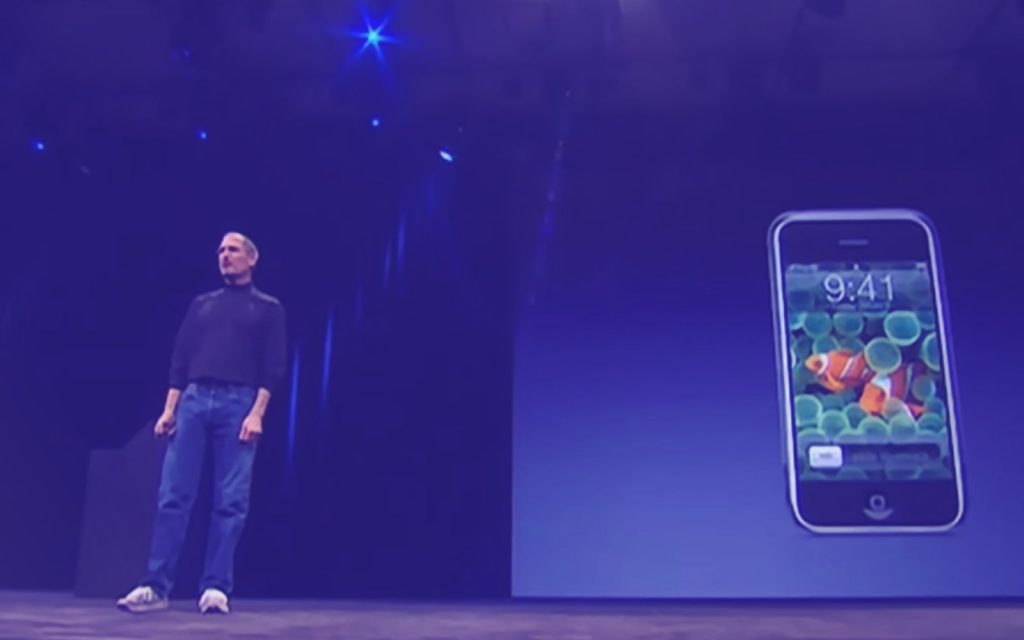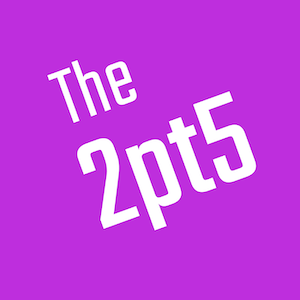The Apple iPhone team had to work hard with lots of iterations to create the „overnight success“ people believe it was. The “Project Purple“ took over two years to get the iPhone launched.
They started out with many iterations of the iPod acting as a mobile phone. The initial idea was the observation of the product team that nobody seemed to be happy with their smartphone at the time.

A „this isn’t enough“ triggered the team to work day and night for two weeks to create the breakthrough moments necessary to create leadership excitement and move ahead with the project. From this 2005 moment it still took another two years until the launch of the iPhone in 2007. On the software side the keyboard was the most difficult part to develop. As things didn’t tag along, all the developer started a hackathon type of development to progress the functionality and solved the problem in a joint effort.
Steve Jobs introducing the iPhone
iPhone 10 years later
Apple’s Secret iPhone Launch Team
Newsletter
Transcript of the iPhone launch team video
This is an automatic transcript, slightly edited. I does contain some inaccuracies.
Apple had never done anything this massive before.
And that’s when Bill told Steve and said Steve this is gonna be bigger than the Mac. And Steve said I know. We looked around and we noticed that almost everyone around us had phones.
And everyone was complaining about their phones. And we thought. Could we build something better?
You know it’s a roller coaster ride. And if it ain’t scary it ain’t fun. The iPod was selling and selling better and better.
It was probably 50 percent of our sales around this time. And so we kept asking ourselves: what is what concerns do we have about the iPod success long term? What will cannibalize iPod sales? And one of the biggest concerns was cell phones.
First we were making the iPod plus phone with a way of a hardware keyboard because it was using the interface of the iPod. Well we tried I think 30 40 different ways of making the wheel not become an old rotary phone. Dial. Right. And nothing seemed logical or intuitive. And so at the end of that you couldn’t you could select from a list right. That was what the iPod was all about. But then to actually dial a real number it was so cumbersome it was like This is never going to work. And I remember one day sitting at lunch with Steve and I both had our phones out and Steve said you know that technology we’re building to do touch for the tablet. Could we shrink that down into something the size of something could fit in your pocket.
And make a phone out of that technology. Steve goes: come over here. I need to show you something.
I said: Sure, show me something. And so he walked me into the room and he goes: It was basically like a ping pong table sized demo. With a projector that was projecting a Mac interface on it and he was like: check this out. I was. And you would use your whole hand and you could touch different things like it was a big mac. He’s like: look at it. And I can type and I can do three and I can do it. I’m like: Let’s get all around it and do it. And it was literally a ping pong sized multi touch display. And he goes: I think this is gonna solve our problem.
There was a time in 2005 I think it was that we’d been doing a lot of designs but the designs weren’t quite there yet. It just didn’t feel complete. And Steve came to one of our design meetings and he said: this isn’t good enough. Like this is it. You have to come up with something so much better. This is not good enough.
You didn’t have to read tea leaves. I mean he said: you don’t start showing me something good soon.
I’m going to give the project to another team.
They have two weeks. And so we went back and Greg assigned different specific ownership of different pieces of the design to different people. And that team worked one hundred and sixty eight hours a week for two weeks. And they just, they never stopped. When they did stop. Greg got them a hotel room across the road so they wouldn’t have to drive home if they lived in San Francisco. And at the end of those two weeks and we’re looking at this thing and thinking: This is phenomenal. Like this is it. We have cracked it.
The first time he saw it he was completely silent. He didn’t say a thing. And say a thing and the gesture and ask a question and you sat back and said: show to me again. And so we go through again. We go through the whole thing again. Steve was pretty much blown away. By the demonstration. Was great work. A reward for doing a great job on that demonstration was to kill ourselves or in the next two and a half years.
The biggest science project of the entire endeavor I think for software was the soft keyboard. We knew we would create a keyboard but we knew we’d be compared against the BlackBerry and BlackBerry was the most popular smartphone out at the time. It’s called the crack berry, right.
We hadn’t seen multi touch in action right. Was multi touch touchscreen actually going to deliver a good enough. And how good is good enough compared to this keyboard?
This crack berry keyboard you know we’re bringing up a whole vocabulary. We’re bringing up a visual vocabulary with the touch and directions would be like pinch to zoom and the scrolling behavior with the rubber banding the bounce at the end of the scroll to indicate you’re at the end of the list. It was all new. I remember we got somewhere in.
It was early 2006 and I could see the light at the end of the tunnel for for the iPhone. At least I could see when it was going to ship. The keyboard wasn’t there. Its accuracy was poor. It was just it was hard to use your arms or an email. You’d give up. And so I went and I froze all development on all applications and every UI developer at this point moved over and I said we’re gonna spend a few weeks and everyone’s building keyboards. And at the end of say three weeks we all got together in a conference room when we got up and started demoing the keyboards they created some of these just crazy. I mean you do these gestures is super complex gestures that were really hard to learn. One guy came in with his keyboard and looked like a natural quirky keyboard kind of keyboard you use on your computer look just like that. You start to use it. And it worked amazingly well. It was so accurate. Which is completely different from the one we had three weeks earlier that looked similar but didn’t work at all. We started digging into what did you do. And they’re all these techniques he used A.I. techniques and others to.
Figure out what you’re trying to type. So if you type the letter T. There’s a high probability you’re gonna type H next to does a common word. So the H button would stay the same physical size to your eye but the hit region would grow. And so when you went toward the age you’re probably in hip age now and now the E is probably huge as a hit region and you’re gonna hit the e it would figure these things out.
We have all these teams learning in parallel right. We had to have an intensity. And so we all meet like a 1.0 prototype phone and we’re like if we would have known what we know now back when we were making this prototype we would have done this differently in this differently in this round. And we’re like OK blow it up now let’s. Build the real one.
And that’s what was shipped and we were given you know OK the screen is gonna be this big right. And then we were given plastic prototypes of the touchscreen technology. We knew the general form factor but it was a while before we saw anything approaching final industrial design just as we weren’t seeing the hardware at the time. The team working on the hardware wasn’t allowed to see the software all the time. I mean it was very compartmentalized. We put a poster up on the wall that was the poster a fight club.
Was the first rule of Fight Club. You don’t talk about Fight Club The first rule about the purple project that was that code name was you don’t talk about the purple project.
I can’t speak to the efficiency but I can tell you that it worked because not one person knew what iPhone was going to look like right before that keynote. People thought they knew that Apple was doing the phone but nobody knew what they were going to see that day in January at the keynote.
Every once in a while a revolutionary product comes along that changes everything. And we are calling it an iPhone.
We demoed almost every feature. We played music. We took calls during music. We we went to really just large and complex web sites.
I mean it was a major real demo and everything was live. So I sat there sweating the whole time. I was so nervous about it.
When you run into bugs today that’s because it’s been worked out like then. It’s just the first time like. And you would go. Okay press this one now wait two seconds. Press this now. It was so choreographed. If you went off the script. It could right. So you had to make sure when the demos knew exactly what they were supposed to do at which time do a great demo MacWorld Expo the people in the audience are either media Apple employees. Or people who would pay money. To go to this conference about you know.
The products of their favorite computer company. It’s pretty industry specific. The fact that you saw people in lines around stores or in line stretching into parking lots at not just Apple stores. But at every AT&T store. Was, in retrospect really the first inkling that this is going to have a broader societal impact. Rather than just being the best phone ever.
Innovators out there
This is not an actual episode of The 2pt5 podcast. I included this story into the new series of “Innovators out there” as innovator Steve Jobs and people from the iPhone team are talking about launching the iPhone. And I think there is something to learn from these videos.
